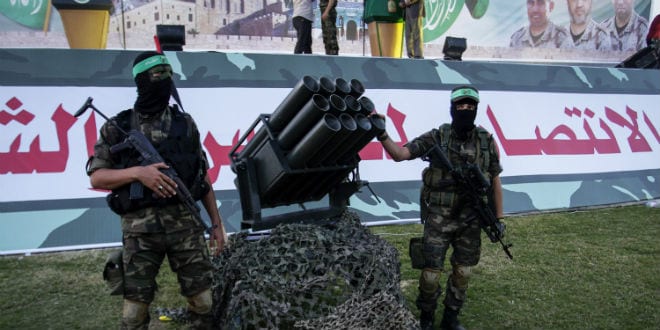The Gaza border is quiet now. It’s hard to even imagine that two months ago Hamas was preparing for war with Israel, readying rockets in underground bunkers that lined its “Metro” system of tunnels running the length of the Gaza Strip. Much of that arsenal, some 15,000 or more rockets, were being prepared for a conflict with Israel that would begin on May 10 with a salvo aimed at Jerusalem.
Leanne Manshari, a therapist and sexual education supervisor in an education department within the Education Ministry, was concerned because she was preparing a pajama party sleep over for one of her children. One of her children was also going to be in Jerusalem for the flag parade. She looks back, two months later, and says the conflict didn’t surprise her. “We expect it in the back of our minds all the time, while living a normal and happy life here. She recalls the tensions up until the May Operation Guardian of the Walls began. “We know there will be a conflict, just as all Israelis know,” she says.
Manshari is one of many millions of Israelis that found themselves under rocket fire in the last war. It was a war in which Hamas used massive barrages of rockets, more than 100 at a time, to saturate southern and central Israel. Hamas fired more than 4,000 rockets, sending thousands running for bunkers or safe rooms in each assault.
The Iron Dome air defense system intercepted many of the rockets that would have impacted urban areas. Nevertheless dozens of rockets made it through and caused casualties. Even if they hadn’t impacted and harmed people, the interceptions and sirens leave a lasting trauma.
Judith Spanglet, who has lived in Israel for decades and has seen the challenges people face after numerous conflicts with Hamas in Gaza, is a body-oriented psychotherapist. She has produced a book and unique program for aiding people affected by conflict and trauma. Now she runs a program called Connections and Links: From Trauma to Resilience. Over a plate of fresh fruit and fizzy water on her balcony in Ashkelon, she discusses her previous experience working with people suffering trauma such as PTSD and shell shock in Beersheba and Tel Aviv.
She now uses the tools from the therapy she provided in the past to help people. She notes that not everyone who needs therapy can afford it or is willing to even admit they need help, “because they want to say they are strong,” she says. “There are tools you can use to be grounded and people can calm themselves down and get rid of the energy stored when there is trauma, it can be their own trauma or someone else’s,” she says.
She came to Israel when she was 19 years old and is now almost 70. “I grew up with [knowledge of] preventative medicine and if you try to prevent the trauma, if you build resilience, then they might not experience that event in such a traumatic way,” she says. “There are ways to strengthen the community and combine things, it’s not just one way. In 2008 she went to Sderot at the height of the Qassam rocket threat when the town was being emptied of its people. There was no Iron Dome in those days, only the “red alert.” Houses suffered impacts and people had to run for shelter with only 15 seconds to make it to safety. Today Sderot has new model homes and apartments, parks and playgrounds and a small posh shopping center even. It has pretty public shelters, painted so they are part of the fabric of the city.
But in 2008 the bunkers were make-shift, concrete slabs dropped in various places. Spanglet recalls doing a research project back then about what kept people from leaving. She helped organize groups of women who came to sessions to learn about the tools they could use in the face of adversity as they suffered from the rockets. The project also developed a program for children. They focused on helping people cope through their bodies and mind. Eventually these programs became part of a network of Resilience Centers across communities near the Gaza border affected by the conflict. There are now six of these centers with the latest opened in Ashkelon.
Today on her balcony in Ashkelon the soft winds from the sea are a constant fan, keeping an otherwise hot city from being too warm in these early summer months. Ashkelon is pretty and modern and people who call it home adore it. But the war was jarring for some. This is because the rockets are getting larger and stronger in their impacts. Hamas has shifted from when it targeted Sderot to targeting cities like Ashkelon. Some families here and in Sderot took their kids out of the city during the recent conflict.
“We have a program of 14 sessions and now they asked us to do it for the kindergartens, and they wanted us to start in June, and it came right after Guardians of the Walls and they asked me how to choose the kindergartens [to assist],” says Spanglet. She discusses the challenges facing children and also the parents who are concerned about raising kids under this threat.
Manshari has lived in Ashkelon since 2010 and brought her kids up here. They are used to the sirens and threats but her youngest child has been more anxious after the recent operation, she says. After two days of the recent operation, she and the family left for the duration, coming back after the ceasefire. She recalls the pajama party for one of her kids the first night of the war. It was surreal she says. “There was a huge amount of rockets fired and this is the reality, you can’t even conceive, how can this be,” she recalls. From the apartment the sirens can be heard easily as well as the interceptions. “There were a lot that fell,” she says, recalling the impacts of rockets in Ashkelon.
“Everyone who lives in this reality is traumatized,” she says. “You need to survive, you do what you have to do, when we came back it was like everything came back to normal. I’m five minutes from the beach front, we came back on Friday with the ceasefire and the next day we took a walk on the beach. You go back to reality so quickly,” she recalls. Flags had been placed in areas where rockets had impacted. It showed the extent of the rockets that fell. “It’s scary. On the other hand I love Ashkelon and it’s a thriving city. I don’t want to be felt sorry for. People are happy and the city is developing really nicely. It’s packed here, the beach is great.”
Across the areas of Israel that were impacted by the war, the feeling of normality has returned. There isn’t much evidence that a war ever happened. At Nahal Oz overlooking Gaza, the Israeli community founded in 1951 which has always been at the gates of Gaza, there is quiet. In the distance a farmer drives near fields festooned with melons that are about to burst from the heat. In Gaza some vehicles are gathering gravel. On the highway back from Sderot to Ashkelon a large truck is transporting two M113 APCs. They are going north, away from the now silent guns. They are likely being retired, to be replaced with new armored personnel carriers. Israel has used them since the 1960s. They’ve seen enough war.
Reprinted with author’s permission from Middle East Forum





